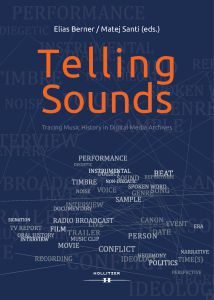Elias Berner/Matej Santi (eds.), Telling Sounds. Tracing Music History in Digital Media Archives, Hollitzer Verlag, Vienna 2023.

Following up on Music – Media – History (transcript, Bielefeld 2021), Elias Berner and Matej Santi have now published the second book of the project “Telling Sounds”. While their first publication—based largely on contributions to an international conference held at the mdw in 2019—was released at the project’s outset, the present volume serves as something of a concluding summation. Telling Sounds started from the assumption that the advent of audio/video media’s permanent availability (in particular via the Internet) has made a gigantic archive of source material available for musico-historical research that can yield new realisations in conjunction with the use of digital humanities tools. The focus here is on music embedded or referenced in formats such as radio programmes, reports, interviews, and films—which is to say, on the music’s presence and use outside the “history of musical heroes”.
Six case studies map out this area of interest, with the first two—by Paul Gulewycz and by Peter Provaznik and Julia Jaklin, respectively—addressing one of the project’s central objectives: the custom-developed software LAMA (Linked Annotations for Media Analyses), a tool with which to inventory, describe, research, and analyse recorded sounds. Four further texts delve into concrete matters that involve audio-visual material as a source: Aylin Basaran investigates the devolution of the newsreel format Austria Wochenschau from an important instrument of national identity-formation during the 1950s to a media curiosity by the early 1980s; Meike Wilfing-Albrecht deals with the constructed and actual post-1945 Mahler renaissance; Elias Berner and Birgit Haberpeuntner present an analysis of the live radio coverage of the Austrian State Treaty based on which the follow-up project ACONTRA (Affective Construction of National Temporalities in Austrian Post-War Radio) is now being conducted; and Birgit Michlmayer examines the “Austropop” construct on the basis of oral history interviews.
In sum, this slender volume offers fascinating insights into what is still a rather young field of musico-historical research. It is to be hoped that academic study of such “telling sounds” continues to gather momentum following the conclusion of this project and that numerous further publications of this type still lie ahead.

